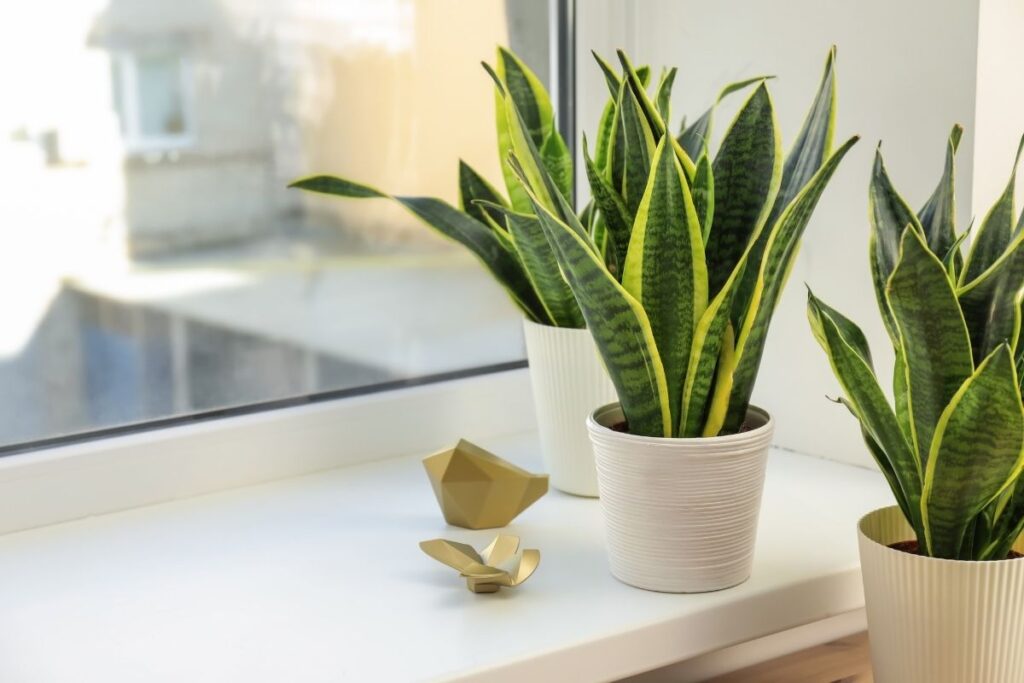Sansevieria can turn yellow. Yellow leaves are often an avoidable part of growing and maintaining any plant. And the Sansevieria is not exempt. Know the reasons your Sansevireia is changing color!
Read on to find out why your Sansevieria leaves may be turning yellow and what exactly you can do about it.
Sansevieria Overview
The Sansevieria plant is more commonly known as the snake plant. This is because the leaves look like snakes all tangled up together.
It first made an appearance in parts of Africa and is now a popular houseplant across the world.

Reason 1 – Over Watering
The Sansevieria is an easy plant to look after. Why is it easy? Because you don’t have to water it every day.
This plant does not get on well with too much water in its soil. There’s a good chance that, if you have been excessively watering your snake plant, the leaves are beginning to turn yellow. The biggest tell of too much moisture is yellow leaves.
This plant likes to be left to its own devices. Looking after it properly means making sure the soil has the right amount of moisture. They need less than you think. They prefer a dryer soil and only need a single top up a week.
The most important part to watering your snake plant is to make sure that the bottom of the pot, where the roots lay, drains properly. If it is left too wet, the snake plant will begin to rot from the bottom, going swiftly up. Ultimately, the plant will die.
Reason 2 – Under Watering
Overwatering leads to our next potential problem. Under watering your snake plant. It’s true, they don’t need much. But Sansevieria need a bit of water from time to time to keep them alive and kicking.
If you neglect them too much, a little more than they would like you to anyhow, this can have a range of consequences.
The first, most noticeable sign, is that the leaves will start to turn yellow. They will also go dry and brittle. They might even fall off if you fail to water the plant for too long. When the leaves are yellow, brittle, and falling off, then your plant is near the end of its life.
Related: Snake Plant (Sansevieria): How To Get Your Plant To Flower and More
Reason 3 – Insects
Another reason why you might be seeing yellow leaves on your Sansevieria is an infestation.
There are three different types of insects that might decide to make a home on your snake plant. If any of the three of them take hold, then there is a good chance that your leaves will turn yellow. Insects are not easy to get rid of, but you have to try, else risk the life of your plant.
Mealybugs
Mealybugs have an oval shaped body. They thrive on plant life and eat leaves to survive. They are mainly found indoors because it is warm and there is a reliable source of fodder.
Mealybugs are hard to get rid of, but not impossible. You might have to find a professional to help you completely exterminate them.
Spider Mites
Spider mites have tiny but powerful teeth. They can build their webs on the leaves of your snake plant. They also bite through every single leaf that they can find until there is not much plant left.
If you have spider mites, you have to act quickly. They spread fast and can migrate to your other houseplants at surprising speeds.
Aphids
Aphids are another tiny bug that might like to live on your snake plant. They live in large groups, and they work fast through leaves. They can move from plant to plant really easily, so they need dealing with quickly.
Aphids might be easy to spot or really difficult, depending on their color. Red and yellow aphids, for example, are much easier to see crawling around your Sansevieria than the brown or green variety.
Reason 4 – Sunlight
Okay, it’s a well established fact that plants need sunlight to grow, right? Yes, that is true. However, the snake plant can suffer if exposed to too much sunlight.
It needs to be kept in a shaded area, preferably never exposed to direct sunlight at all. A little here and there will give it enough to survive, but that is the line.
You know the feeling of spending a day under the sun’s rays. It can lead to sore skin and even burns. Well, the snake plant is extremely hypersensitive to the sun’s rays.
That sensation of sunburn can happen within the space of half an hour. A Sansevieria that has been set in the sun will take no time at all in turning yellow on the leaves. So, keep it away from windows and definitely keep it inside.
Related: 21 Types of Sansevieria – Indestructible, Exotic, and Elegant Air Purifiers
Reason 5 – Fungal Infection
Last but not least, we have fungal infections. Fungal infections can be a result of too much water in the soil. They can cause the roots to rot. This can lead to a spread of fungal infection that can cover all of your plants.
The leaves will turn yellow, and the plant will die.
Fungal infections can also be a direct result of an insect infestation.
Conclusion
So if your Sansevieria is looking a bit on the yellow side of the green, these are the five things to check for.
Rule each one of them out, and take action if required. Your plant should gain its healthy green glow back in no time.
Editor’s Recommendations
Pothos Vs. Philodendron: How To Tell Between The Two Popular Houseplants?
How to Propagate Prayer Plant: Things To Consider
Variegated String Of Pearls 101 | How To Grow & Care For This Dazzling Succulent!







